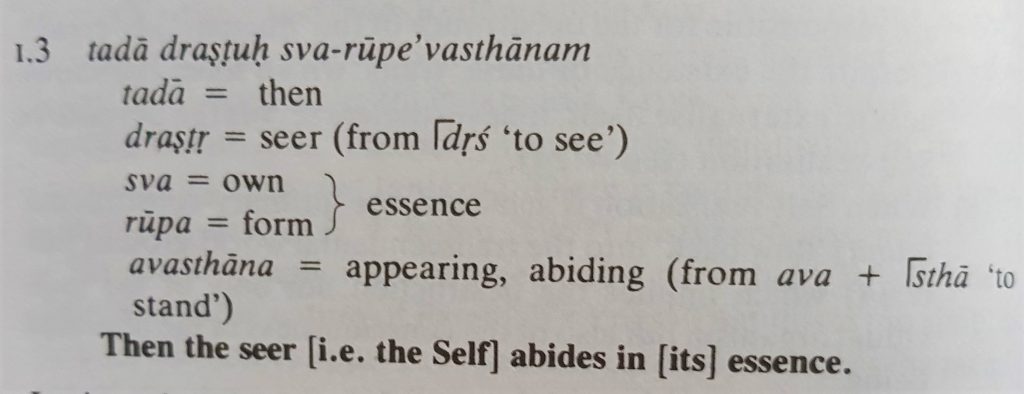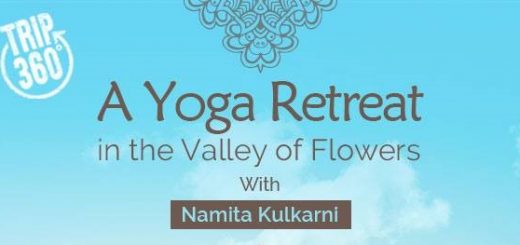A Yoga Sutra for International Yoga Day & Every Day
The most neglected part of modern Yoga seems to be the philosophy underlying it, the core of Yoga as expressed in the Yoga Sutras of Patanjali. As it turns out, profound aphorisms that delve into the nature of the mind – with layers of insight and meaning – don’t lend themselves well to hashtags, 3-second attention spans, and visual media. Is it any surprise that somewhere along the way Sthira Sukham Asanam got elbowed out by Lights Camera Action?
Around this International Yoga Day, it seems fitting for me as an Indian Yoga teacher to share my 2 cents of wisdom drawn from the ocean that is the Yoga Sutras. Being Indian gave me the privilege of studying Sanskrit in school for 4 years and having the language swirl around me in ways big and small, whether I noticed or not.
And yet – in the spirit of full disclosure – it took me a good 5 years of teaching Yoga before I began to really look into and study the Yoga Sutras, beyond having a cursory understanding of some of them. So it’s been about 3 years now, meaning I just about have a toehold on some fraction of the wisdom in the Sutras – on a good day. But even that little toehold offers a rich enough treasure of perspective and sanity I’m grateful to be able to draw from on my not-so-sunny days. Which is an embellished way of saying there’s one less psychopath on the planet thanks to the Yoga Sutras.
So what are the Yoga Sutras? Without going into their history, provenance and that big old question of ‘Who was Patanjali?’ (that’s a whole other blogpost/book/library), the Yoga Sutras are the foundation and core of Yoga. Four chapters of Sanskrit aphorisms that delve into the nature of the human mind. In my humble experience, strange Sanskrit phrases one minute and truth bombs that slice into your soul the next. Ideas that sound alien, far out, and abstract at first when they just don’t seem to land on you, and ring true to your core one fine day while you’re doing your laundry. For instance, the following Sutra which I count as one of my favorites. Hope you can relate to it too in your own way.
Chapter 1, Sutra 3: Tada drastuh svarupe vasthanam

Picture courtesy: Georg Feuerstein’s commentary on the Yoga Sutras
This Sutra is also interpreted as:
Then, the seer dwells in his own true splendour (BKS Iyengar)
Then pure awareness can abide in its very nature (Chip Hartranft)
A sense of homecoming peeps through those words. To me, it resonates with all the times I’ve stepped into my practice – or anything that engages all of me – and felt a sense of taking a walk on the insides of what I call ‘me’. Feeling into my self after a day of being externally oriented and playing out all the labels, roles, and patterns I’ve managed to accumulate over three decades and three years.
In a Yoga Philosophy course I studied last year with Judith Lasater (one of my favorite teachers), she offered this example to explain the meaning of this Sutra: “We need to knock on the temple door long enough to realize we are already IN the temple. And that’s what practice is. It’s not the state of Yoga or integration but it helps us open to the possibility of our own home. The part of us that knows is in the “being” state of the wisdom. That settles into itself and is no longer stirred up. We’re home”. And that is what the practice means to me on any day when I venture beyond the usual patterns: self-criticism for not “getting” a pose, guilt for not “working hard enough”, coveting poses I see other people rock, and various other episodes of the soap opera that modern postural Yoga throws us into if we’re not watchful. The practices are signposts pointing you to your way back home. Nothing more and nothing less. I wouldn’t want to be another oh-so-spiritual/esoteric person who looks down on the physical practices for being “just physical” (as if even the most “spiritual/esoteric” among us don’t inhabit physical bodies subject to physical laws), but I do like to remind myself often that my practice is a tool, not the goal. The finger pointing to the moon, not the moon itself. Signposts that I would be well-advised to spend my time and energy on, as long as I don’t forget what they’re pointing to.
So take all the signposts you need and dance with them all day if you please, but don’t forget to let them walk you home. That being the gift inside all the attractive packaging, why miss out?
Happy International Yoga Day every single day that you choose to cherish the gift that has always been yours, waiting to be claimed. A little more each time, one way or another.





i love this article……..yoga is useful for anyone…however some people relate this with religion… yoga gives you energy…
Hi again Namita! Thanks for another thoughtful post. I agree, it’s a lovely sutra. I prefer the second translation. It raises interesting questions about what is the nature of mind. It also seems to invite a sense of resting in that peaceful nature. I’ve also been writing about a sutras, but from the Buddhist tradition; the Six Paramitas. It would be great to hear your thoughts on it: https://www.zenyoga-berlin.de/blog/six-paramitas/. Greetings from Berlin! 🙂
Hi Tatjana, so great to hear from you again and thank you for your kind words! Enjoyed reading your post and these lines especially: “Not holding onto thoughts and experiences, even when they appear to be important, is generosity practice. And since there’s no giving without receiving, by letting go of what’s so dear to us – our thoughts, opinions, emotions, fixations – we receive something in return. Something very precious – the gift of insight.” About the ego, my view is that it need not be destroyed. A healthy functioning ego is a necessity. It’s the attachment to the products of ego that needs to be examined, such as our thoughts, opinions, emotions, fixations as you mentioned. Judith Lasater talks about ego here, you might find it an interesting read too: http://www.judithhansonlasater.com/writing/2014/11/20/tb7p1jhvohw7l9s03w3e6wxxtooy4p
Looking forward to more posts from you!